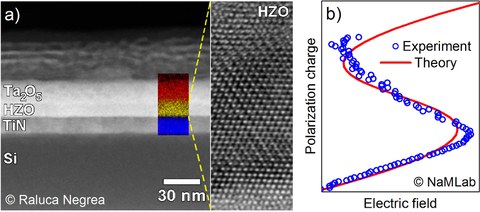Jan 15, 2019
Controversial theory of materials science finally proven
Researchers from Dresden, Germany have verified a fundamental theory of ferroelectric materials which could lead to more energy-efficient electronics.
Scientists at the Nanoelectronic Materials Laboratory (NaMLab gGmbH) in collaboration with Researchers at Dresden University of Technology and the National Institute of Materials Physics, Romania have demonstrated that thin layers of ferroelectric hafnium zirconium oxide can exhibit a phenomenon called “negative capacitance”. This means that such materials can amplify a voltage, which could be used to reduce the power dissipation of future electronics beyond conventional limits. While this peculiar behavior was already predicted over 70 years ago, until now, most scientists thought that it was impossible to show this experimentally. Since the materials used in this study can already be found in every advanced computer chip today, future products utilizing this new discovery, e.g. more efficient smartphones or computers, might not be far away.
While ferroelectric materials have been thoroughly investigated for almost a century, some fundamental questions have remained unresolved. One of them is related to the “Landau theory” of ferroelectrics from the 1940s, which is still used to describe the behavior of ferroelectric materials today. However, the theory also predicts a negative capacitance, which has been controversially discussed, especially in recent years. The theory suggests that an increase of electric charge can lead to a decrease of the voltage, which is exactly opposite to a regular capacitance. A scientist at NaMLab gGmbH has now first demonstrated a measurement of such a negative capacitance in exceptional agreement with Landau theory.
This discovery was enabled by using specially fabricated capacitors, consisting of a stack of ultrathin layers, to which extremely short voltage pulses were applied. The results have been published on January 14, 2019 in the prestigious journal Nature. “The fascinating thing is that the materials in which we discovered this promising effect are already used in every smartphone,” said Michael Hoffmann, Ph.D. student at NaMLab and lead author of the study. “However, the next important step will be to use these findings to develop new devices, which in theory could be much more energy-efficient than anything that is possible today.”
The scientific publication can be found online under: http://dx.doi.org/10.1038/s41586-018-0854-z
The work has received funding from the Electronic Component Systems for European Leadership (ECSEL) Joint Undertaking under grant agreement No 692519. This Joint Undertaking receives support from the EU’s Horizon 2020 Research and Innovation programme and Belgium, Germany, France, Netherlands, Poland, United Kingdom. Additionally, part of this work was supported by the EFRE fund of the European Commission, by the Free State of Saxony and through the Core Program of the Romanian Ministry for Research and Innovation.
About NaMLab
The Nanoelectronic Materials Laboratory gGmbH (NaMLab) was founded in July 2006. It is now a non-profit subsidiary company and an associated institute of the TU Dresden. The company runs research facilities with four labs, a clean room and office area for more than 40 scientists and employees on the campus of the TU Dresden. Material research and development combined with the implementation in nanoelectronic devices are the goal of NaMLab´s activities. Scientists of NaMLab are closely cooperating with the institutes of the TU Dresden. www.namlab.com
Media inquiries:
Michael Hoffmann
Tel.: +49 351 21249-9016
Thomas Mikolajick

